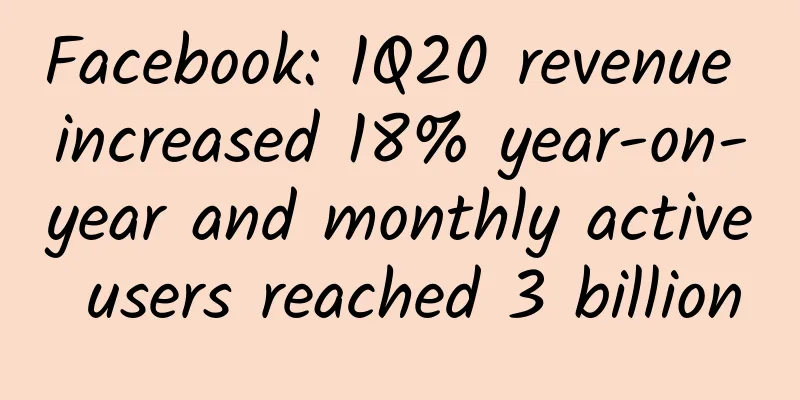Facebook: 1Q20 revenue increased 18% year-on-year and monthly active users reached 3 billion

|
According to FB's first quarter 2020 financial report and conference call, the COVID-19 pandemic had a negative impact on the company's advertising revenue, but the use of FB by users increased during the pandemic, and the company actively launched new products and features to meet user needs. At the same time, it worked with authoritative medical institutions to provide users with correct health information services, and took financial and product measures to help companies affected by the pandemic recover. FB's response to the epidemic (1) Helping people stay connected, including helping them connect to authoritative health information and limiting the spread of misleading information; (2) Assist public health departments in responding to the epidemic, including helping government departments and medical institutions collect information for decision-making; (3) Promote economic recovery, especially for small and medium-sized enterprises. Usage and strategy of FB products during the epidemic Currently, more than 3 billion people use Facebook, Instagram, WhatsApp or Messenger every month. Of these, 2.6 billion use Facebook, and more than 2.3 billion use at least one of its products every day. In the areas hardest hit by the epidemic, the volume of messages increased by more than 50%, and voice and video calls on Messenger and WhatsApp doubled. Maintaining stable and reliable services during the epidemic is the company's top priority, and the company's countermeasures include monitoring and expanding data centers. Before the epidemic, the product strategy focused on building a private social platform and enabling online business. The epidemic showed that these functions are what users need. Last week, FB announced product improvements to its video system, which include three aspects: video calls, video chat rooms, and live broadcasts. Video calling is the most widely used video chat feature, with more than 700 million daily active users on WhatsApp and Messenger. The company has increased the number of people who can make a video call on WhatsApp from 4 to 8. Thanks to WhatsApp's end-to-end encryption feature, users can communicate with more family members and larger groups via video chat. In terms of video chat rooms, the company has launched a new product called Messenger ROOMs. The idea is that you can create a room for any reason, send the link to your friends, or post the room link on Facebook and invite people to come and play for a while. The unique thing about this experience is that it is impromptu and you don't need to plan in advance. Live streaming has also become particularly important. In the past, people mainly used it to live stream offline events, but now it can be used for all kinds of activities. More than 800 million people on Facebook participate in live content such as classes and concerts through live streaming every day. In terms of helping small and medium-sized enterprises and promoting economic recovery, because many physical stores cannot open, many companies are looking for online displays. The company is doing a lot of work to enhance these experiences. The company has invested $5.7 billion in India's Jio platform. One of the investment goals is to open up business opportunities for small businesses. WhatsApp has been deeply imprinted in Indian life. During the epidemic, Facebook's free display tools came in handy, and the company launched new products for companies to cope with the changing environment. The company quickly launched gift card features on Facebook and Instagram, and opened the fundraising function that was previously only open to non-profit organizations to local service companies. The company also temporarily changed its services to allow companies to share important information such as inventory changes, delivery information, and purchase methods. In March, the company launched the Business Resource Hub to provide support and training for companies to help them better migrate online. The company announced a $100 million funding program to support 30,000 small and medium-sized enterprises and $100 million to support the news industry. User and Financial Data As people flock to Facebook, its usage is also increasing, with daily active users reaching 1.73 billion, an increase of 11% year-on-year, accounting for 67% of the 2.6 billion monthly active users. MAU increased by 10% year-on-year, with a net increase of 228 million people. Total revenue in the first quarter was US$17.7 billion, an increase of 18% year-on-year, and a year-on-year increase of 19% at constant exchange rates. Advertising revenue was $17.4 billion, up 17% year-on-year. The impact of the COVID-19 pandemic on revenue began in the second week of March, when advertising revenue began to decline significantly. Different industries performed differently, with the travel and automotive industries performing the weakest, while the gaming, technology and e-commerce industries performed strongly, and this trend continued in the second quarter. The COVID-19 pandemic has had different impacts on different parts of the world, with advertising revenue growing by 21% in the Asia-Pacific market, followed by North America, Europe and the rest of the world, all with year-on-year growth of 16%. In the first quarter, ad impressions increased by 39% year-on-year, and the average ad price decreased by 16%. The increase in impressions mainly came from Facebook's mobile information feed and increased user usage during the epidemic. The decline in ad unit price mainly reflected the shrinking demand from advertisers in the last three weeks of March. Other revenue was $297 million, up 80% year-over-year, primarily from sales of Oculus products, with the company launching the Quest device in May 2019. Total expenses were $11.8 billion, up 1% year-on-year. Excluding the expenses of the FTC settlement in the first quarter of last year, total expenses increased by 35% year-on-year. Among them, operating costs increased by 23%, mainly from depreciation of infrastructure expenses such as servers. R&D expenses increased by 40%, mainly from investment in core products and innovative products, especially VR/AR. Marketing and sales expenses increased by 38%. Excluding the impact of FTC expenses, G&A increased by 49% year-on-year, part of the increase came from estimated credit losses caused by the new crown epidemic. In the first quarter, the company had more than 3,300 new employees, with a total of 48,000 full-time employees, a year-on-year increase of 28%. Operating profit was $5.9 billion. The operating profit margin was 33%. Net profit was $4.9 billion. Earnings per share were $1.71 Capital expenditures were $3.7 billion, primarily spent on data centers, servers, office buildings and network equipment. The company had free cash flow of $7.3 billion, and cash and investments totaled $60.3 billion at the end of the quarter. The company invested $5.7 billion in Jio Platforms in India. Regarding the second quarter, the current situation shows that due to the impact of the epidemic, advertising revenue is flat year-on-year, and the situation in April is still weak. The company expects total expenditures in 2020 to be US$52-56 billion, lower than the earlier US$54-59 billion, due to weak revenue, which is expected to have a negative impact on operating profit margins. |
<<: yStats: Instant payments will account for 8% of total transactions in China by 2025
Recommend
Wilson's disease, how to choose copper-containing foods?
Wilson's disease is an autosomal recessive co...
What causes bacterial vaginitis?
What causes bacterial vaginitis? Bacterial vagini...
Physiological standards: international standards for judging women's sexual ability
How can we objectively judge or evaluate a person...
Artificial insemination of polycystic ovary syndrome was successful at one time
For many women, polycystic ovary syndrome is a ve...
Pregnant women's childbirth knowledge: how to choose the correct delivery method
We all know that childbirth is related to the lif...
What should you pay attention to after induced abortion for fetal heart malformation?
Everyone hopes to give birth to a healthy baby, b...
What are the symptoms of intestinal obstruction after cesarean section
Nowadays, many pregnant women give birth through ...
Bleeding after successful implantation
The development of the fertilized egg in the uter...
How to treat female vulvar leukoplakia
Nowadays our living environment is constantly cha...
What should I do if I have severe constipation during breastfeeding?
Constipation during breastfeeding is relatively c...
International Tea Day, do you know what are the taboos and precautions of drinking tea?
May 21st of every year is International Tea Day. ...
Is breast burning a disease?
Breasts are the main reproductive organs of women...
Does brown blood two days before menstruation mean pregnancy?
When a woman becomes pregnant, she will definitel...
How to prevent bleeding in early pregnancy
A friend told me a few months ago that she was pr...
29 weeks fetal movement decreases and becomes gentle
The physical condition of the fetus during pregna...









